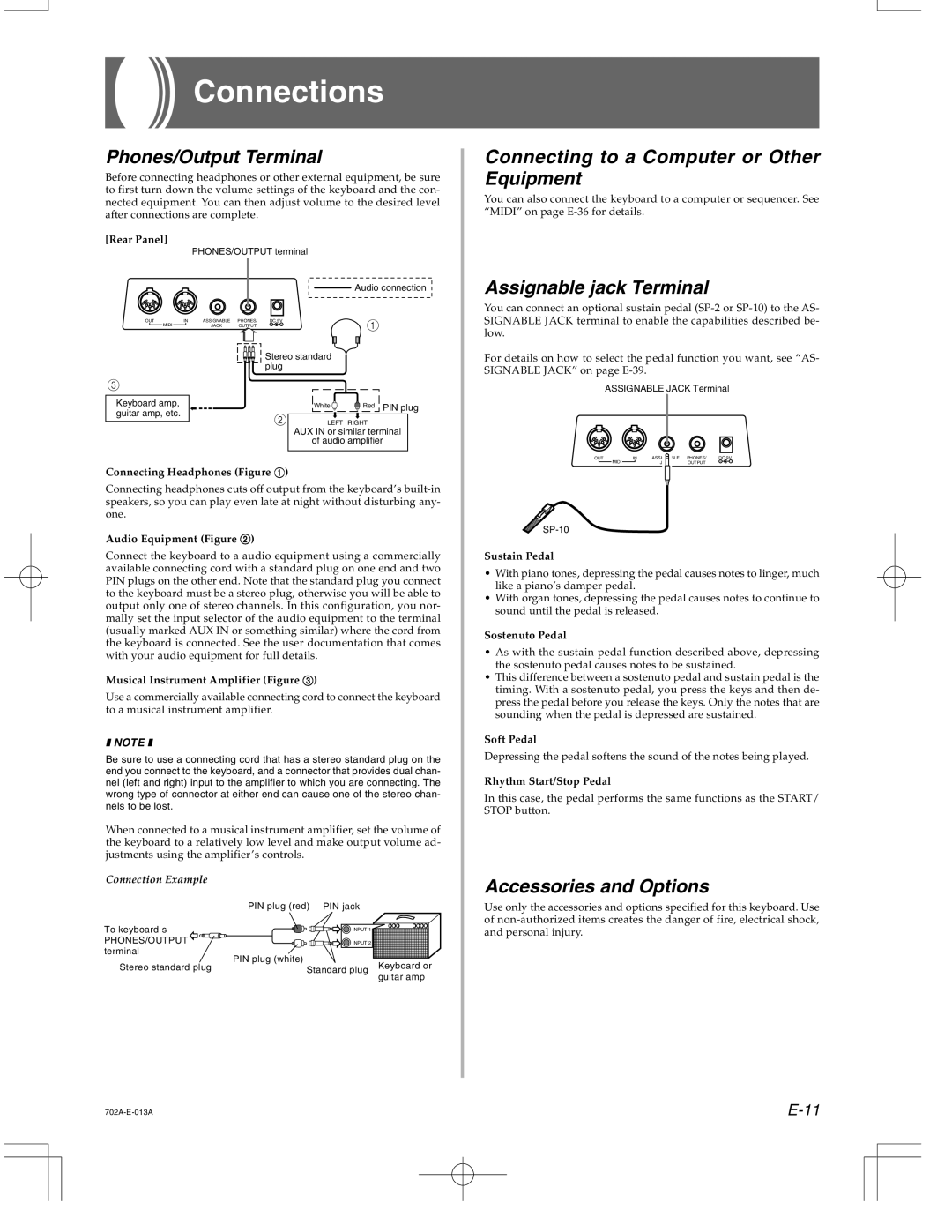
Connections
Phones/Output Terminal
Before connecting headphones or other external equipment, be sure to first turn down the volume settings of the keyboard and the con- nected equipment. You can then adjust volume to the desired level after connections are complete.
[Rear Panel]
PHONES/OUTPUT terminal
Audio connection
Connecting to a Computer or Other Equipment
You can also connect the keyboard to a computer or sequencer. See “MIDI” on page
Assignable jack Terminal
OUTIN
MIDI
3
Keyboard amp, guitar amp, etc.
ASSIGNABLE | PHONES/ DC 9V | 1 |
JACK | OUTPUT | |
| Stereo standard |
|
| plug |
|
| White | Red PIN plug |
2LEFT RIGHT
AUX IN or similar terminal
of audio amplifier
You can connect an optional sustain pedal
For details on how to select the pedal function you want, see “AS- SIGNABLE JACK” on page
ASSIGNABLE JACK Terminal
OUT | IN | ASSIGNABLE | PHONES/ | DC 9V |
MIDI |
| JACK | OUTPUT |
|
Connecting Headphones (Figure 1)
Connecting headphones cuts off output from the keyboard’s
Audio Equipment (Figure 2)
Connect the keyboard to a audio equipment using a commercially available connecting cord with a standard plug on one end and two PIN plugs on the other end. Note that the standard plug you connect to the keyboard must be a stereo plug, otherwise you will be able to output only one of stereo channels. In this configuration, you nor- mally set the input selector of the audio equipment to the terminal (usually marked AUX IN or something similar) where the cord from the keyboard is connected. See the user documentation that comes with your audio equipment for full details.
Musical Instrument Amplifier (Figure 3)
Use a commercially available connecting cord to connect the keyboard to a musical instrument amplifier.
❚ NOTE ❚
Be sure to use a connecting cord that has a stereo standard plug on the end you connect to the keyboard, and a connector that provides dual chan- nel (left and right) input to the amplifier to which you are connecting. The wrong type of connector at either end can cause one of the stereo chan- nels to be lost.
When connected to a musical instrument amplifier, set the volume of the keyboard to a relatively low level and make output volume ad- justments using the amplifier’s controls.
Connection Example
| PIN plug (red) PIN jack |
To keyboard s | INPUT 1 |
PHONES/OUTPUT | INPUT 2 |
terminal | PIN plug (white) |
| |
Stereo standard plug | Standard plug Keyboard or |
| guitar amp |
Sustain Pedal
•With piano tones, depressing the pedal causes notes to linger, much like a piano’s damper pedal.
•With organ tones, depressing the pedal causes notes to continue to sound until the pedal is released.
Sostenuto Pedal
•As with the sustain pedal function described above, depressing the sostenuto pedal causes notes to be sustained.
•This difference between a sostenuto pedal and sustain pedal is the timing. With a sostenuto pedal, you press the keys and then de- press the pedal before you release the keys. Only the notes that are sounding when the pedal is depressed are sustained.
Soft Pedal
Depressing the pedal softens the sound of the notes being played.
Rhythm Start/Stop Pedal
In this case, the pedal performs the same functions as the START/ STOP button.
Accessories and Options
Use only the accessories and options specified for this keyboard. Use of
